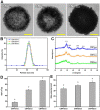Harnessing the tunable cavity of nanoceria for enhancing Y-27632-mediated alleviation of ocular hypertension
- PMID: 33859757
- PMCID: PMC8039939
- DOI: 10.7150/thno.54525
Harnessing the tunable cavity of nanoceria for enhancing Y-27632-mediated alleviation of ocular hypertension
Abstract
Background: Y-27632 is a potent ophthalmic drug for the treatment of ocular hypertension, a globally prevalent eye disease. However, the sustained delivery of Y-27632 by a therapeutic carrier to lesion sites located in the inner segments of the eye for effectively treating the ocular disorder still remains challenging. Methods: To realize the goal, a strategy based on solvothermal-assisted deposition/infiltration in combination with surface modification is utilized to synthesize hollow mesoporous ceria nanoparticles (HMCNs) with tailorable shell thicknesses and drug release profiles. The shell thickness of HMCNs is rationally exploited for achieving sustained drug release and advanced therapeutic benefits. Results: The shell thickness can regulate release profiles of Y-27632, displaying that thick and thin (~40 nm and ~10 nm) shelled HMCNs reveal burst release characteristics (within 2 days) or limited drug loading content (~10% for the 40 nm thick). As a compromise, the HMCNs with moderate shell thickness (~20 nm) possess the most sustained drug release over a period of 10 days. In a rabbit model of glaucoma, a single instillation of the optimized Y-27632-loaded HMCNs can effectively treat glaucoma for 10 days via simultaneously repairing the defected cornea (recovery of ~93% ATP1A1 mRNA levels), restoring the reduced thickness of outer nuclear layer to normal (~64 µm), and restoring ~86% of the impaired photoreceptor cells. Conclusion: A comprehensive study on the importance of HMCN shell thickness in developing long-acting nano eye drops for the efficient management of glaucoma is proposed. The findings suggest a central role of nanobiomaterial structural engineering in developing the long-life eye drops for pharmacological treatment of intraocular diseases.
Keywords: Y-27632; ceria nanostructure; hollow carrier system; ocular therapeutics; shell thickness.
© The author(s).
Conflict of interest statement
Competing Interests: The authors have declared that no competing interest exists.
Figures






Similar articles
-
Effects of shell thickness of hollow poly(lactic acid) nanoparticles on sustained drug delivery for pharmacological treatment of glaucoma.Acta Biomater. 2020 Jul 15;111:302-315. doi: 10.1016/j.actbio.2020.04.055. Epub 2020 May 16. Acta Biomater. 2020. PMID: 32428681
-
Dually functional hollow ceria nanoparticle platform for intraocular drug delivery: A push beyond the limits of static and dynamic ocular barriers toward glaucoma therapy.Biomaterials. 2020 Jun;243:119961. doi: 10.1016/j.biomaterials.2020.119961. Epub 2020 Mar 9. Biomaterials. 2020. PMID: 32171102
-
Montmorillonite/chitosan nanoparticles as a novel controlled-release topical ophthalmic delivery system for the treatment of glaucoma.Int J Nanomedicine. 2018 Jul 10;13:3975-3987. doi: 10.2147/IJN.S162306. eCollection 2018. Int J Nanomedicine. 2018. PMID: 30022821 Free PMC article.
-
Medical management of glaucoma: focus on ophthalmologic drug delivery systems of timolol maleate.Artif Cells Nanomed Biotechnol. 2017 May;45(3):448-459. doi: 10.3109/21691401.2016.1160917. Epub 2016 Mar 22. Artif Cells Nanomed Biotechnol. 2017. PMID: 27002850 Review.
-
Sustained release ocular drug delivery systems for glaucoma therapy.Expert Opin Drug Deliv. 2023 Jul-Dec;20(7):905-919. doi: 10.1080/17425247.2023.2219053. Epub 2023 Jun 12. Expert Opin Drug Deliv. 2023. PMID: 37249548 Review.
Cited by
-
Evaluation of the Ocular Safety of Hollow Mesoporous Organosilica Nanoparticles with Different Tetrasulfur Bond Content.Int J Nanomedicine. 2024 Jul 16;19:7123-7136. doi: 10.2147/IJN.S464524. eCollection 2024. Int J Nanomedicine. 2024. PMID: 39055375 Free PMC article.
-
Tacrolimus Loaded Cationic Liposomes for Dry Eye Treatment.Front Pharmacol. 2022 Feb 4;13:838168. doi: 10.3389/fphar.2022.838168. eCollection 2022. Front Pharmacol. 2022. PMID: 35185587 Free PMC article.
-
Regenerative cerium oxide nanozymes alleviate oxidative stress for efficient dry eye disease treatment.Regen Biomater. 2022 Sep 21;9:rbac070. doi: 10.1093/rb/rbac070. eCollection 2022. Regen Biomater. 2022. PMID: 36324607 Free PMC article.
-
Exploring the Long-Term Tissue Accumulation and Excretion of 3 nm Cerium Oxide Nanoparticles after Single Dose Administration.Antioxidants (Basel). 2023 Mar 21;12(3):765. doi: 10.3390/antiox12030765. Antioxidants (Basel). 2023. PMID: 36979013 Free PMC article.
-
Ocular Surface Disease and Dry Eye Severity in Glaucoma Patients at Urban Private Eye Care Centres in Malaysia.Clin Ophthalmol. 2024 Nov 14;18:3249-3262. doi: 10.2147/OPTH.S476779. eCollection 2024. Clin Ophthalmol. 2024. PMID: 39559252 Free PMC article.
References
-
- Tham YC, Li X, Wong TY, Quigley HA, Aung T, Cheng CY. Global prevalence of glaucoma and projections of glaucoma burden through 2040: a systematic review and meta-analysis. Ophthalmology. 2014;121:2081–2090. - PubMed
-
- Zhang K, Zhang L, Weinreb RN. Ophthalmic drug discovery: novel targets and mechanisms for retinal diseases and glaucoma. Nat Rev Drug Discovery. 2012;11:541–559. - PubMed
-
- Kotecha A. What biomechanical properties of the cornea are relevant for the clinician? Surv Ophthalmol. 2007;52:S109–S114. - PubMed
-
- Wiederholt M, Thieme H, Stumpff F. The regulation of trabecular meshwork and ciliary muscle contractility. Prog Retin Eye Res. 2000;19:271–295. - PubMed
Publication types
MeSH terms
Substances
LinkOut - more resources
Full Text Sources
Other Literature Sources
Research Materials

